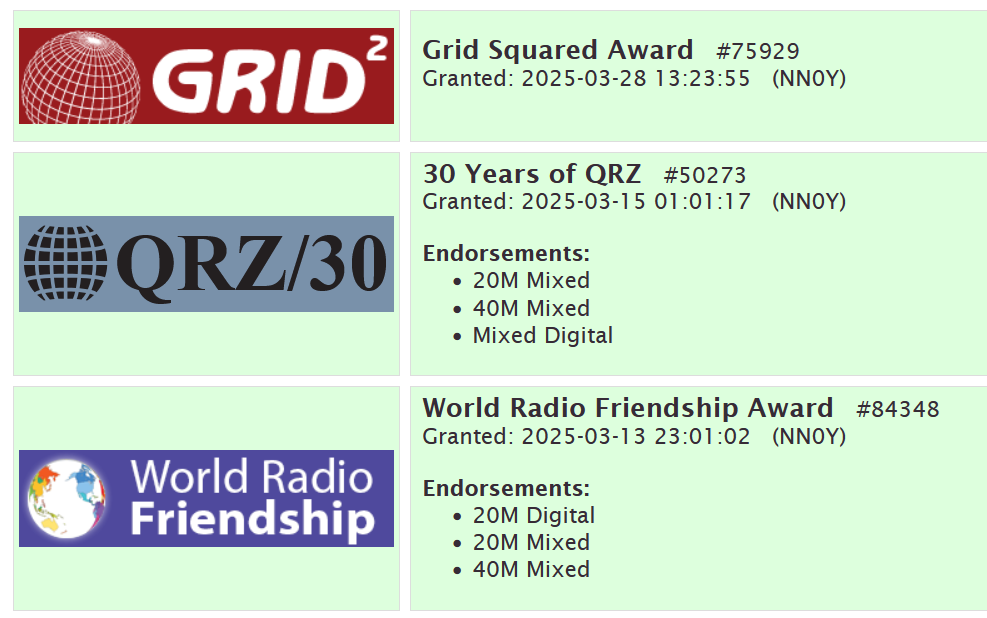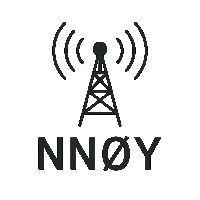Awards
So the receiver prototype will have to wait a bit. It had some real issues and I can’t believe that I ever got it to receive any intelligible audio. I’ll be back with a revamped design in a couple of weeks/months, but I’ve been very distracted with using the radios that I have and that are working. I am not a big fan of SSB or other voice modes, mainly because using those modes means you have to actually talk to people. Even over the air I have a hard time making conversation. But I discovered that there are still popular ham radio modes that aren’t voice based. The most popular is a digital mode called FT8.
It took me a bit to get my Yaesu FT-950 interfaced with my computer correctly. It seemed like all the other websites that had configuration options were wrong for my setup. It may be that their computers or interface cables worked differently- the FT-950 has one jack for both packet and RTTY modes, and I had to do a lot of manual reading and chasing continuity with a multimeter before I figured out how things worked.
After finally figuring things out, it is kind of fun to use FT8, waiting for a CQ and getting a response. There is a bit of a learning curve with the software but it isn’t too bad. After making contacts with FT8, I got set up on eQSL.cc, QRZ.com, and the Logbook of the World lotw.arrl.org. Getting on eQSL and QRZ wasn’t too bad, but getting on LotW took over a week- you have to register, they mail you a postcard to your address registered to the FCC license, and then you put in the code from the postcard, and then they send you your account information and a digital signing/encryption certificate a day or two later. Man, that is such an old-school process, no wonder there are a ton of people who don’t use LotW.
Along with getting registered on the online log sites, I had to learn where to find the ADIF file (with file extension .adi) and remember not to uplod the .log file, which is a way nicer file format and extension (also, why does WSJT-X make two log files?). But now the magic can happen:
- You operate FT8 and log your contacts (click the “prompt me to log” checkbox and the software will remind you)
- When you are done operating for the day, upload your ADIF log to eQSL, QRZ, and LotW (via tqsl software).
- The logs process fairly quickly.
- And then you get to see CONFIRMATIONS of your logged contacts, which means you weren’t falling victim to unusually structured noise.
- After enough confirmed contacts and meeting certain criteria, you can get awards!

Yes, I feel a real sense of validation from these digital logos. I am not going to pay $25 for a printed certificate, but I am excited about the awards. They are proof that I made contact with a variety of people around the world. I am excited to try and get more awards with more modes and on more bands.
When I first got my amateur license I didn’t do much with it- mainly because I didn’t have somebody to mentor me (called an Elmer), and the only easy thing to do was have boring conversations (called rag chewing) with other guys on the radio. If I had an Elmer to coach me through some of the other parts of amateur radio, I might have found the parts of ham radio that excite me sooner. I will keep on using digital modes to seek out more awards, but now that I know how proud I am of these initial awards, I will use that as motivation to try out new modes of operating, and to try CW, and to try POTA and SOTA!
73, NN0Y
P.S. Here are my radio settings that I had to figure out for myself. If you don’t have a FT-950, just skipt this, it is mostly a reminder in case I ever have to set up the FT-950 on another computer, or if there is anyone struggling to get their (almost) two-decade old radio connected to the computer.
- Radio in PKT (not RTTY) mode- this is the only mode that takes in audio from the rear panel
- Supposedly you could run in SSB but would need to put the audio in through the front mic input
- Must be in USB
- Pkt shift setting must be 1300 Hz
- Pkt display shift must also be 1300 Hz (so the commanded frequency matches what you would get from normal SSB/USB operation)
- CAT BPS must match your computer comm port setting, I normally do 38400 bps
- Tx power must be 50W or less to keep from burning up the radio
- Menu settings must be SAVED with long press of menu button (changes are lost if you short press)
- Antenna must be connected and tuned
- The green audio plug goes in the computer headphone port
- The blue audio plug goes in the computer mic port
- Set default audio to headphone/mic, turn off all system sounds
- CAT to usb cable must be attached
- WSJT-X must set up on the right com port, 8N1 work for serial, CAT works for PTT
